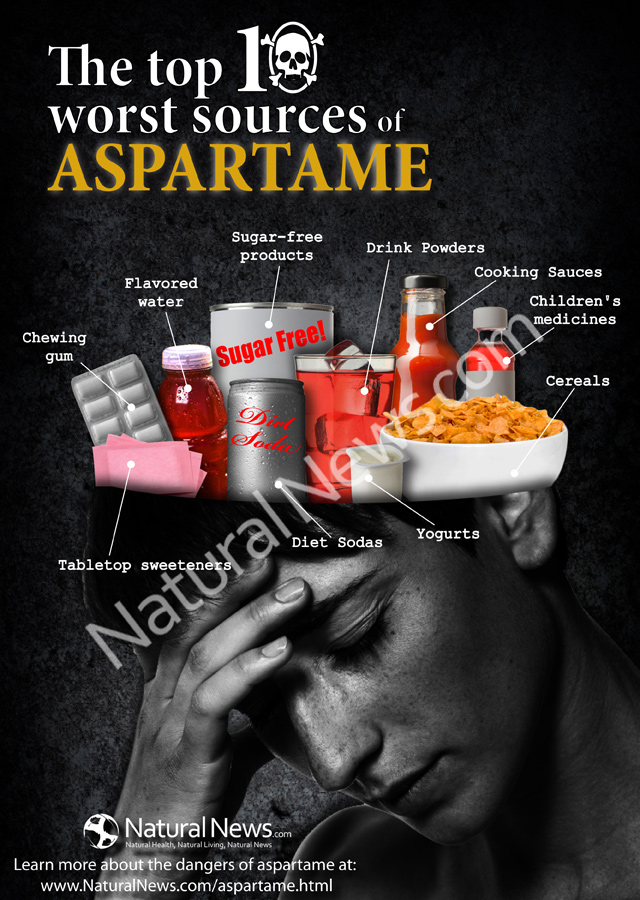Why aspartame is dangerous
75 percent of reported adverse reaction to food additives is attributed to aspartame. Of these reactions, many are serious and include seizures and death. A number of the 90 documented symptoms as reportedly caused by aspartame are headaches/migraines, dizziness, seizures, nausea, numbness, rashes, depression, irritability, insomnia, hearing loss, vision problems, loss of taste vertigo and memory los.
Those who study the adverse effects of aspartame report that the following medical conditions are triggered or worsened by aspartame: brain tumors, multiple sclerosis, chronic fatigue syndrome, mental retardation, Parkinson's disease, epilepsy, lymphoma, birth defects, diabetes and fibromyalgia.
And that's not all -- according to Victoria Iness-Brown in her book "My Aspartame Experiment," aspartame is also addictive.
What is aspartame composed of?
To understand the effects of aspartame one must look at its genetic composition. This substance - which is 200 times sweeter than sugar - is made of 50 percent phenylalanine, 40 percent aspartic acid and ten percent methanol.Aspartic acid
Russell Blaylock, a neurosurgery professor at theMedical University of Mississippi, describes aspartic acid as an isolated amino acid that is just as toxic as glutamate, another popular additive. Aspartic acid is an excitotoxin, a chemical that excites the brain to the point of death. It alters the manner of brain formation in newborn infants, permanently resulting in hyperactivity and behavioral changes in children.
In its free form, unbound from proteins, it significantly raises the plasma level shortly after ingestion. The excess aspartate in the blood shortly after ingestion leads to high levels in certain areas of the brain. It slowly begins to destroy neurons and a large part of neural cells in a particular area of a brain are destroyed before any clinical symptom of an illness is noticed. Reported physical effects after long exposure to excitatory amino acid include Parkinson's disease, brain lesions, neuroendocrine disorders and hypoglycemia to mention a few.
Pregnant women and lactating mothers increase their risk by consuming aspartame-laden products because the child's brain barrier, which protects the brain from excess aspartate and other toxins, is not developed enough to protect it from this chemical. Moreover, while in the womb and during the first year of life, these compounds can have free access to the nervous system due to the fragility of the infant's blood brain barrier during this stage of development.Phenylalanine
Phenylalanine is an amino acid. Individuals with phenylketonuria, a genetic disorder, cannot utilize phenylalanine, causing possible buildup in the body. Even for persons who are not suffering from phenylketonuria, it has been shown that ingesting aspartame together with carbohydrates can cause increased levels in the body. Excess phenylalanine in the body causes the serotonin levels to dip leading to emotional disorders like depression. Human testing has shown that phenylalanine levels significantly increased in subjects who chronically used aspartame.Methanol
Methanol is a neurotoxin and an extremely harmful substance. The enzyme chymotrypsin facilitates its release in the small intestine. Its absorption is sped up when aspartame is heated above 30 centigrad - or above 86 Fahrenheit - creating free methanol. This normally occurs when products containing aspartame are improperly stored or when subjected to heat.
Normally, methanol breaks down into formaldehyde and formic acid. Formaldehyde interferes with DNA reproduction, retinal damage and birth defects. Its toxicity affects the nervous system, taking approximately ten to thirty hours before symptoms manifest - the most common of which is vision impairment. The symptoms for methanol poisoning have been reported to include dizziness, nausea, gastrointestinal disturbances, memory lapses and numbness to name a few.
A consumption limit of 7.8mg/day is recommended, but a one liter of an aspartame sweetened drink contains about 56 mg of methanol. Heavy users of products containing aspartame consume as much as 250mg of methanol a day or 32 times the recommended limit.
Since humans do not possess certain key enzymes that animal subjects possess, human are more sensitive to the toxic effects of methanol. It is without doubt that animal testing on aspartame or methanol does not accurately reflect the potential danger for humans.Do not wait, act now!
In sum, recent research on aspartame has just revealed what appears to the tip of an enormous iceberg. Defenders of aspartame consistently insist that aspartame is safe to use after having been affirmed by the US FDA 26 times for the last 23 years. However, doubts as to its safety will always linger when well-respected researchers such as Dr. Blaylock and the Ramazzini Foundation speak out about its possible adverse effects and put their reputations on the line for what they believe in. This is even without taking into consideration the questionable circumstance that led to the approval of aspartame in the first place.
Next time you open a diet soda think about the possible consequences. Sometimes, it takes years before a problem manifests itself; by then, it maybe too late for you to do anything about it.











